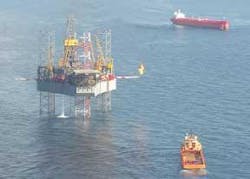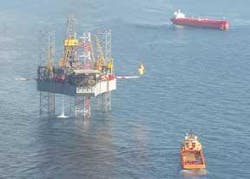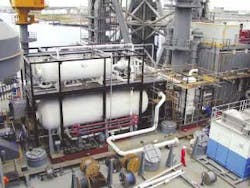UK's first abandoned oilfield restored to active service
Re-development based on drilling/production jackup
Jeremy Beckman
Editor, Europe
Production has resumed at Ardmore in the central North Sea, 11 years after the taps were switched off. This is the first attempted resurrection of an abandoned field in the UK sector, using an entirely different production system. If successful, operator Tuscan Energy will have taken reservoir revival to a new level.
Ardmore – formerly known as Argyll – was the UK's first offshore oilfield development, entering production in June 1975. Operator Hamilton Brothers initially deployed a converted semisubmersible platform. The Trans-world 58 replaced it. Nine years later, another semi with higher grade production and water injection capabilities, the Deepsea Pio-neer, produced the field. This facility also handled incoming oil from the newly onstream Duncan field. The Transworld 58 relocated to nearby satellite Innes on the UK continental shelf (UKCS).
Over time, production declined markedly due to mechanical shut-downs, excessive water ingress, and unpredictable performance from individual wells. These problems could not be resolved using technologies available at the time. During 1991-92, all three fields had to be closed down, with around 97 MMbbl having been extracted, roughly 30% of estimated in-place reserves. The floaters were later sold to new operators in Ghana and Vietnam, but Hamilton – now BHP – did not formally relinquish the production license until 1999.
In January 2002, block 30/24, which contains the three fields and numerous undeveloped prospects, was newly awarded to partners Tuscan Energy (65%) and Acorn North Sea (35%) under a UK out of round licensing process. Both are small independents, formed respectively in 2000 and 2001. Four of Tuscan's directors had previously worked with platform facilities management group Atlantic Power & Gas, later acquired by PGS. Chief Executive Dave Workman had also served as manager of Kerr-McGee's Gryphon project. Acorn's team included ex-BP and Lasmo personnel, with strong capabilities in subsurface engineering.
"When we created our company," Workman explains, "we were looking to take on operatorship of mature fields or marginal discoveries on the UK shelf with no immediate exploration requirement. However, three years ago there looked to be very little in the way of deliverable assets. No one wanted to sell, with the oil price high at the time. But we foresaw Tuscan developing over the coming five years, as big mature assets such as Forties and Beryl started to change hands. That fragmentation is now taking place."
Tuscan examined eight or nine producing fields and came close to acquiring one, also developed through a semisubmersible.
"Our strategy is to gain access to a field at a price where we can move it forward," Workman says. "And we always want to operate the asset. We're not interested in a role as non-operating partner. Platform-based fields in the central North Sea are our natural focus. Subsea is also fine, although that depends on whether you can structure a commercial deal to take the product across to the host facility. Things are improving in the UKCS, with transportation pipeline tariffs becoming more transparent."
Tactics for "creating value" include devising innovative commercial arrangements with lead contractors and willing to act quickly. This approach impressed the UK Department of Trade & Industry, which was anxious to whittle down the UK's backlog of untouched marginal reserves.
"As far as I know, there were other bidders for this license," Workman says. "But since we requested it on an out of round license basis, with our own ideas, the DTI recognized the intellectual capital we had invested, and equally importantly, our technical and financial capability."
By late 2002, financial capital for this project had been secured from private equity investors Aberdeen Murray Johnstone and US Bank Trust Company of the West.
Tuscan's plan involved a phased, £250 million development, the first phase focusing on Ardmore. Here four new high-angle production wells would be drilled (one of the techniques not available to Hamilton), producing up to 25 MMbbl over a two-year period, with a further 15+ MMbbl to be targeted in later phases through restoration of the other satellite accumulations. This would equate to a 10% increase in overall recovery.
null
Faulted structure
Ardmore's location is in 270 ft of water, 15 km west of the median line with Norway, and 60 km southwest of the J-block gas-liquids production complex. According to analysis by Wood Mackenzie, the structure consists of a horst block trending northeast to southwest. The reservoir is situated in a tilted fault block, bounded by faults to the northeast, northwest, and southeast. Main productive reservoir horizons are Zechstein carbonates in the Turbot Bank and Halibut Bank formations, and Auk formation Rot-liegendes and Devonian sandstones.
Tuscan had access to extensive data from 39 wells that had been drilled on the block, and also to 3D seismic that had been acquired by BHP prior to abandonment, in association with Agip, but not fully evaluated. Why this program was authorized remains a mystery.
Initially, the new partners had considered a moored FPSO as Ardmore's central production system. Discussions were held with two vessel owners, Brøvig and Fred. Olsen, but both sides came to the conclusion that the residual capex risks for this project were too high. Subsea tiebacks to other processing platforms in the area were also ruled out.
"Our whole approach is about risk management," Workman explains. "We didn't want to pay out $1 million per kilometer just for a single flowline, because that money, once spent, is never coming back."
Instead, the partners opted for Rowan's Gorilla VII jackup. Like all Rowan's Super Gorilla-class rigs, it has been designed to work simultaneously in both drilling and production modes in hostile, North Sea-type conditions.
"The Gorilla VII had already been offered to us in July 2001, when we had submitted our original license application, but at that time, it was working in the US. Last year, the rig market was depressed, and this unit, being available, provided us with a better commercial and, ultimately, technical solution for the Phase 1 development."
The rig was taken on a lease, initially for 18 months. The contract was sufficient to drill Ardmore's four first-phase production wells with options for a 42-month extension to cover re-development of Duncan and Innes, since re-named Dalmore and Satellite I.
"All the Phase 1 wells feature dry trees, supported at deck level, and all are being drilled sequentially by our contractor GlobalSantaFe on a turnkey basis, as part of our campaign to manage the drilling cost," Workman says. "We also structured a deal with Rowan that gave them some exposure to fluctuating oil prices. On the other hand, Rowan reaps the benefit of a long-term lease for its drilling unit."
The high angle (40-60°) wells will feature open-hole completions and slotted liners. "Otherwise, we are employing no fancy well technology, such as multilaterals. That may be desirable in future, but not for Tuscan's first three-four operated wells."
Hamilton's production scheme had only limited water-handling capacity, with inadequate provision for artificial lift. This eventually forced Argyll's wells to be shut in at relatively low water cuts. Ardmore's wells have been designed for a much higher water cut and are additionally being equipped with 1-MW electric submersible pumps (ESPs). Baker Hughes Centrilift has provided all these and the associated downhole monitoring and completion systems and topsides-related power equipment.
"This is another example of our innovative approach to risk management," Workman adds. "The ESPs have also been taken on a leased basis. If they run longer, this generates automatic benefits to the ESP provider. From our point of view, leasing, where possible limits our capex exposure, improves our funding capability, and focuses our contractors on delivery. We encourage our contractors to also take responsibility for operating their equipment. People in the service sector are always saying, 'give us more opportunities to be innovative.' What they actually need is more responsibility for everything in their area. We couldn't have done Ardmore without our service providers taking on this role because a company our size can't fund a project unless we know exactly how much it will cost."
Process design constraints
In September 2002, Expro's Production Solutions Group based in Reading, UK, was contracted to supply the Rowan Gorilla VII's process topsides equipment on a five-year lease, operate, and maintain basis, valued at £17 million. The equipment was delivered in July to the McNulty Offshore yard in South Shields, northern England, where the Gorilla VII was undergoing preparatory modifications. The topsides were designed to process up to 60,000 b/d of incoming well fluids, and to operate with a range of water cuts to a maximum of 40,000 b/d of oil or 40,000 b/d of produced water.
For Ardmore, Expro was involved in both the engineering, design, and procurement phases, says Raj Lekhy, Production & Testing Solutions group manager. "Normally when we work on early production facilities, we don't have much data on the field. This one, however, had previously been in production for 17 years, so there was plenty of reservoir and fluid data available. This helped to eliminate a lot of the uncertainty from the topsides design. We brought in DNV to provide independent third party certification of our hazardous operation studies."
null
The Ardmore process plant was built at Steel Services in Great Yarmouth, UK. Expro had worked with them before several years ago on smaller scale applications for FPSO developments. The Ardmore facility has to handle fluids at an incoming temperature of 120° C, with light, sweet crude at 39° API. What Expro essentially is doing is de-gassing and de-watering the fluids, stabilizing the hydrocarbons, then pumping them via the export line for tandem offloading to Ardmore's dedicated shuttle tankers.
"This rig is a very large, new generation jackup, which is designed for SIMOPS – simultaneous drilling while producing. One major criterion for us was that while the process plant was being installed, the jackup would be drilling simultaneously, so space would be very tight. Some of the largest platforms in the North Sea only produce 60,000 b/d, and this jackup was not even designed for permanent production. What we did, therefore, was to stack a lot of our separation equipment, thereby maximizing production capacity from the four wells while minimizing the footprint area," Lekhy said.
The Phase 1 topsides is arranged on three levels. On the main deck level, the equipment comprises a four-well inlet manifold, a large first stage separator, and the crude oil export system – pumps, coolers, and export metering.
"There are no test separators. In-stead, we use a multiphase flow meter, purpose-built by Roxar and positioned at the inlet manifold, for testing at rates of 10,000-20,000 b/d. Not only does this significantly reduce the equipment footprint, but it also enhances real-time monitoring of production," he said.
Also included on this level are the flare knock-out vessels, the fuel gas conditioning skid, the chemical injection system, and a purpose-built control room complete with an office and HVAC system. Two associated 100-ft flare booms, both purpose-built with proprietary high and low-pressure flare tips, have been installed on the jackup's port and starboard sides for continuous burning of gas. Power generation, required primarily for the ESPs, is provided by a 2-MW gas-fired turbine supplied by Alba Power.
Production from Ardmore started flowing at the end of September at 15,000 b/d, 20 months after project sanction, and should build to 40,000-50,000 b/d in 1Q 2004. Oil is piped 1.5 km to two single anchor leg mooring buoys, supplied by APL, and offloaded to the two shuttle tankers operated by Ugland Nordic Shipping. Other service providers on long-term contracts include SBS Logistics, offering logistics management from Aberdeen Harbor and storage services from its complex inland at Edzell, a former Royal Air Force base. Nomis Shipping has a five-year contract for standby and shuttle assistance, using its multi-purpose vessel the Dea Commander.


